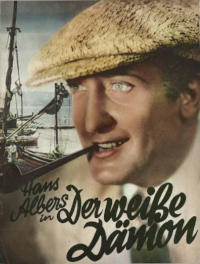
Original Title: Der weiße Dämon. (Rauschgift.) Thriller 1932; 106 min.; Director: Kurt Gerron; Cast: Hans Albers, Lucie Höflich, Gerda Maurus, Trude von Molo, Alfred Abel, Hans-Joachim Schaufuß, Raoul Aslan, Peter Lorre, Hubert von Meyerinck, Klaus Pohl, Eduard von Winterstein; Ufa-Klangfilm.
A consul leads an international drug smuggling gang using a theater troupe as a cover. A young man discovers his sister’s severe morphine addiction and confronts the gang, revealing the consul as the mastermind. With a new ally, he liberates his sister and dismantles the criminal organization, forging a lifelong friendship before returning to Hamburg.
Summary
Hein Gildemeister returns to Hamburg after several years working as a planter in South America to visit his mother and sister. Gerda, his sister, is a famous operetta singer. Despite her great success, she appears sick and unhappy to her brother. Hein investigates the cause of her condition and eventually discovers that Gerda is addicted to morphine. A deep resentment towards those who introduced and habituated the young and beautiful woman to the drug consumes the farmer. He tries in vain to track down these individuals, even Gerda’s friend Dora, also an actress, refuses to reveal anything to Hein. Suddenly, Gerda is abducted. When Hein receives a telephone call from his missing sister, leading him to a remote district of Hamburg, he is attacked and barely manages to escape. He then embarks on a pursuit of the people who have taken Gerda for some reason. The chase takes him to Paris and then Spain. The international criminal organization of drug dealers has extensive connections, and Hein often feels that all his efforts are in vain. However, he eventually succeeds in exposing the leader of the gang high up in the sky on an airplane. The man commits suicide by jumping out of the plane. Hein and Dora, who has become a loyal ally to the young man, return home as a happy couple.
Georg Herzberg’s review in Film Kurier No. 274 (November 21, 1932)
The film kicks off with a sensation: Hans Albers leaping from an ocean liner into the sea to rescue a boy who fell overboard. The hero is returning to Hamburg after five years to reunite with his mother and sister. To his shock, he discovers that his sister, who pursued a career in theater, has fallen into morphine addiction, leading to a physical breakdown. Determined to find those responsible, he uncovers an international drug smuggling gang, embarking on an exhilarating chase across half of Europe.
In this tale penned by Philipp Lothar Mayring and Friedrich Zeckendorf, there are numerous moments that please the audience: the vibrant atmosphere of the stage, the romance of seedy dives, the cunning tricks of the drug smugglers, thrilling pursuits, and stunning outdoor shots at sea, in Paris, and Lisbon. And at the center of it all is Hans Albers, the charismatic and daring hero, the tender son and brother, the triumphant embodiment of goodness triumphing over evil. Albers portrays various situations that have made him popular, allowing himself to be sentimental and a dutiful son to his mother. His performance is effortless, as always, leading to great success for both himself and the film.
Director Kurt Gerron excels in capturing the criminal scenes and creating moments that evoke laughter from the audience. Although he has limited experience with dramatic scenes in his previous works, the boundaries of his abilities become apparent here. However, perhaps the resourceful director, who has enjoyed a successful career, can still overcome these limitations. Unfortunately, Trude von Molo falls short, as she fails to move beyond monotonous declamation. On the other hand, Gerda Maurus shines in her challenging role as the drug addict, convincingly portraying the misery of someone trapped by poison and passionately warning against the use of narcotics.
At this point, it must be reiterated how perplexing it is that certain government authorities sought to censor the treatment of the drug issue in films. This work stands as a powerful indictment of drug abuse. Films like this reach millions of viewers and serve as far more impactful counter-propaganda than the well-intentioned but often limited educational efforts of the authorities, which mostly reach those already affected by addiction but fail to inform the masses.
Peter Lorre embodies the criminal archetype with precision, and Hubert von Meyerinck proves to be a worthy accomplice. Both actors are skillfully guided by Gerron. The ensemble is completed by Raoul Alsna, Lucie Höflich, Alfred Abel, and the young Hans-Joachim Schaufuß.
Carl Hoffmann’s cinematography particularly shines in the outdoor shots. Julius von Borsody skillfully constructs the theater sets and the slums of Hamburg. Walter Rühland manages the sound, and Hans Otto Borgmann provides the music, utilizing Offenbach’s La belle Hélène.
The audience was captivated by the thrilling events and enthusiastically applauded when Hans Albers appeared on the screen. This film is destined to be a new hit in the Ufa program.